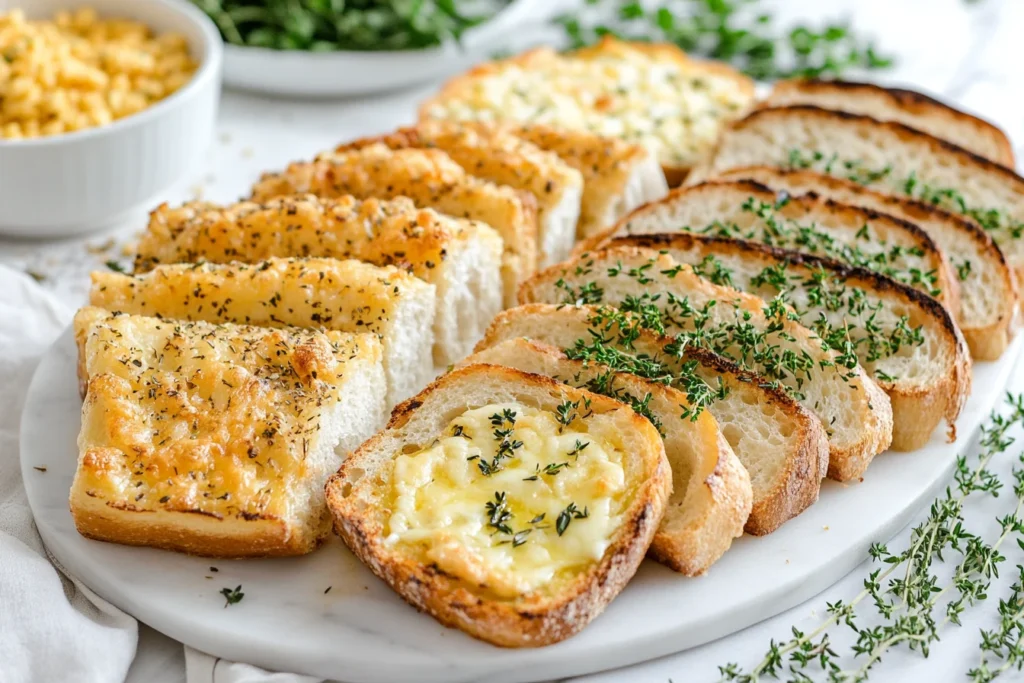Few dishes can match the universal appeal of garlic bread. With its crispy crust, buttery texture, and robust garlic flavor, it has become a staple in many households. This beloved dish serves as the perfect complement to pasta, soups, and even salads. Despite its simplicity, garlic bread continues to be a favorite across cultures, enjoyed in numerous variations.
Whether served as an appetizer or a side, garlic bread brings warmth and comfort to the table. Its signature aroma alone is enough to make anyone’s mouth water. The combination of freshly baked bread, melted butter, and garlic creates a dish that is both indulgent and satisfying. Understanding its history, preparation methods, and various styles provides deeper insight into why it remains so popular.

Table of Contents
Why Garlic Bread Is So Popular Worldwide
The widespread love for garlic bread is no accident. It perfectly balances crunch, softness, and a bold, savory taste. Its appeal stems from a few key factors:
- Simplicity – The dish requires only a handful of ingredients, making it accessible to all.
- Versatility – It complements various cuisines, particularly Italian and Mediterranean dishes.
- Irresistible Aroma – The scent of roasted garlic and warm butter is enough to captivate anyone.
- Customizability – From cheesy variations to herb-infused recipes, garlic bread adapts to personal preferences.
Across cultures, this dish has been adapted to include different herbs, cheeses, and bread types. Despite regional variations, the core appeal of garlic bread remains unchanged.
Why Do People Love Garlic Bread?
The Perfect Combination of Flavors
The magic of garlic bread lies in its flavor profile. The richness of butter, the pungency of garlic, and the crunch of toasted bread create a harmonious blend. These contrasting yet complementary textures enhance the overall dining experience.
Its Versatility as a Side Dish
No matter the meal, garlic bread serves as the ideal accompaniment. It pairs seamlessly with:
- Pasta dishes like spaghetti and fettuccine alfredo.
- Soups and stews to soak up flavorful broths.
- Grilled meats and seafood for added texture.
Its adaptability makes it a staple at family dinners, festive gatherings, and casual meals alike.
Ingredients Needed
The Essential Ingredients
Creating authentic garlic bread requires a few key ingredients:
- Bread – Baguette, Italian bread, or sourdough for the best texture.
- Butter – Softened, unsalted butter for a rich taste.
- Garlic – Freshly minced garlic delivers maximum flavor.
- Parsley – Adds freshness and color.
- Salt and Black Pepper – Enhances the overall taste.
Optional Ingredients to Enhance the Flavor
For added depth, consider these ingredients:
- Cheese – Mozzarella or parmesan for a creamy finish.
- Olive Oil – Adds a slightly different texture and taste.
- Red Pepper Flakes – Provides a subtle kick.
Different Types of Garlic Bread

Classic
This traditional version features toasted bread coated in garlic butter and baked until golden brown. It is simple yet deeply flavorful.
Cheesy
By incorporating melted mozzarella or parmesan, this variation adds a layer of indulgence. The cheese forms a rich, gooey topping that enhances the crispness of the bread.
With Herbs
For a fragrant twist, fresh or dried herbs like rosemary, thyme, and oregano are blended into the garlic butter mixture.
Vegan
Using dairy-free butter and nutritional yeast instead of cheese makes this version suitable for plant-based diets without compromising flavor.
How to Make – Step-by-Step Recipe
Step 1: Gather the Ingredients
Ensure all ingredients are prepped and ready. Fresh garlic and quality bread are essential for the best results.
Step 2: Preparation
In a bowl, mix together melted butter, chopped parsley, minced garlic, salt, and pepper.
Step 3: Spread the Butter Mixture on the Bread
Evenly coat each slice with the garlic butter mixture. For extra crispiness, lightly press the mixture into the bread.
Step 4: Bake to Perfection
Preheat the oven to 375°F (190°C) and bake for 10-15 minutes until golden and crispy. Serve immediately for the best texture.
Tips for Making the Perfect Garlic Bread
Choosing the Best Bread
Selecting the right bread is crucial to achieving high-quality garlic bread. The texture, crust, and density of the bread significantly influence the final result. A French baguette or Italian bread works best because of its crispy crust and soft interior. These types absorb the garlic butter mixture without becoming overly soggy. If a more rustic approach is preferred, sourdough bread provides a slightly tangy flavor that complements the richness of the butter.
Avoid using pre-sliced sandwich bread, as it tends to be too soft and lacks the necessary structure. Additionally, whole-grain or multigrain bread can be an alternative for those seeking a more nutritious option. No matter the choice, always use freshly baked bread for optimal texture and taste. If using frozen bread, allow it to thaw completely before preparing garlic bread to prevent excess moisture from affecting the crispiness.
How to Get the Perfect Crispy Texture
The key to achieving the ideal texture in garlic bread lies in proper baking techniques. Baking at a moderate temperature, around 375°F (190°C), ensures that the butter infuses the bread while allowing the edges to crisp up beautifully. For a more golden crust, broiling for the last one to two minutes enhances the crispiness without drying out the interior.
Another factor that improves texture is spreading the garlic butter evenly. Applying a thick layer ensures deep flavor penetration, while leaving some areas exposed allows for a contrast between crispy and buttery bites. Brushing olive oil on the edges before baking can also add an extra layer of crunch.
To avoid sogginess, bake garlic bread on a wire rack rather than directly on a baking sheet. This method allows heat to circulate evenly, preventing the underside from becoming too soft while keeping the top perfectly crispy.
Health Benefits
Nutritional Benefits of Garlic
Garlic bread not only delivers an exceptional taste but also provides notable health advantages, primarily due to its star ingredient—garlic. This potent herb contains allicin, a natural compound known for its antibacterial and antiviral properties. Regular consumption of garlic supports immune health, reduces inflammation, and may help regulate blood pressure.
Additionally, garlic is packed with antioxidants, which combat oxidative stress and contribute to overall well-being. The presence of vitamin C, selenium, and manganese enhances its nutritional profile. When paired with whole-grain bread, garlic bread also offers dietary fiber, supporting digestive health.
How to Make Garlic Bread a Healthier Choice
For those looking to enjoy garlic bread with fewer calories and less fat, simple modifications can make a difference:
- Use olive oil instead of butter for a heart-friendly option.
- Choose whole wheat or sourdough bread to increase fiber intake.
- Reduce salt and use fresh herbs like parsley or basil for added flavor.
- Incorporate roasted garlic instead of raw for a milder, nutrient-rich alternative.
For more nutritious bread ideas, check out The Secret to a Good Cornbread to explore different bread options.
What to Serve with Garlic Bread?
Best Dishes to Pair with Garlic Bread
Garlic bread complements a wide range of dishes, making it an excellent addition to meals. Some of the best pairings include:
- Pasta Dishes – Perfect with creamy Alfredo, spaghetti Bolognese, or a classic marinara sauce.
- Soups and Stews – Enhances the richness of tomato soup, minestrone, or French onion soup.
- Salads – Adds a crunchy contrast to Caesar, Greek, or Caprese salads.
- Grilled Proteins – Pairs well with roasted chicken, grilled salmon, or steak.
- Dips and Spreads – Ideal for hummus, spinach-artichoke dip, or bruschetta toppings.
By pairing garlic bread with these dishes, meals become more satisfying and flavorful.
Store-Bought vs. Homemade
Which One Is Better?
Both store-bought and homemade garlic bread offer unique advantages. However, the freshness and control over ingredients make homemade versions the superior choice. When making garlic bread at home, it is possible to adjust butter levels, seasoning, and texture to personal preference.
Store-bought options, while convenient, often contain preservatives and artificial flavorings. Pre-packaged varieties may also have an excessive amount of butter or margarine, increasing saturated fat content.
For those short on time, store-bought garlic bread can be a quick fix, but homemade preparations allow for a healthier, fresher, and more customizable alternative.
For more exciting bread-related recipes, explore The Secret to a Good Cornbread and learn how different bread varieties can be used in creative ways!
Can You Store and Reheat Garlic Bread?
Best Ways to Store and Reheat
To keep the bread fresh for later use, proper storage methods are essential. If consuming within a day, wrap it in foil and leave it at room temperature. For longer storage, freezing is the best option.
To freeze:
- Wrap the slices in parchment paper, then seal them in a freezer bag.
- Store for up to three months without compromising flavor.
- The bread may dry out more quickly in the refrigerator, so avoid doing so.
For reheating:
- Oven Method – Bake at 350°F (175°C) for 10 minutes to restore crispiness.
- Toaster Oven – A quick solution for individual slices.
- Stovetop – Heat on a dry skillet over medium-low heat.
- Microwave – Although convenient, this method can make the bread chewy rather than crispy.
Fun Facts
Interesting Trivia
- Garlic bread has strong Italian-American roots, but in Italy, it is not traditionally served with pasta.
- The earliest versions of garlic-infused bread date back to ancient Rome, where people spread crushed garlic on flatbreads.
- In some regions, garlic bread is served with dipping sauces such as marinara or ranch.
- National Garlic Bread Day is celebrated on April 6th in honor of its widespread popularity.
- Some gourmet variations include truffle butter, caramelized garlic, or even chili-infused oil for added depth of flavor.
Conclusion
Garlic bread remains a culinary favorite due to its simplicity, rich flavor, and versatility. Whether made at home or purchased pre-made, it offers a delightful combination of crispy edges and buttery goodness. Understanding how to select the best bread, achieve the perfect texture, and pair it with various dishes enhances the overall experience.


1 thought on “The Ultimate Guide to Garlic Bread – Crispy, Buttery, and Irresistible”